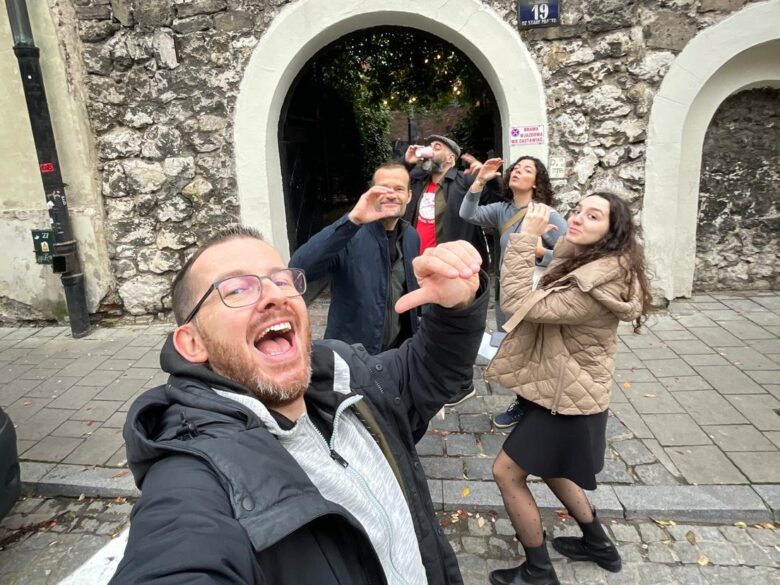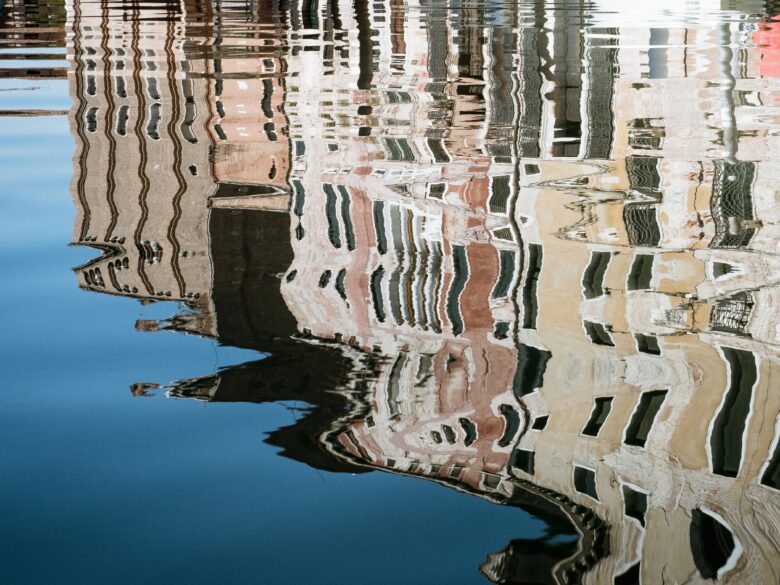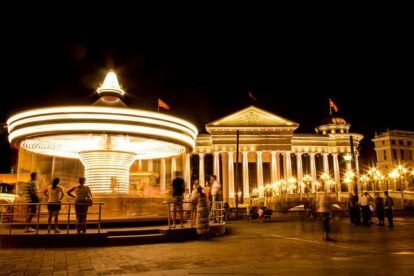
Spinning Sround (Skopje Carousel) – by Marjan Lazarevski (flickr.com)
Limited in its expansion by the scenic mountain ranges that surround it, Skopje spreads along the Vardar river. Its strategic position, in the heart of the Balkan peninsula, made this territory a crossroads of cultures, religious faiths and people. Skopje fortress, standing on its highest point, has been watching over the city for more than a thousand years and reminds us that, once upon a time, this territory witnessed frequent battles and occupations. Inhabited since Prehistorical times, flourishing Roman colonia, throughout the centuries Skopje was contended first between the Byzantines and the Bulgarian Empire, and after the Serbians and the Ottoman Empire, remaining under the control of the latter for 500 years.
With a population of just over half a million, Skopje is far from being a metropolis. At the turn of the XX century it was no more than a provincial town within the borders of the Kingdom of Yugoslavia (hence the lack of a monumental, haussmannian layout). The city became the capital of the newly declared independent state of Macedonia (also called FYROM) only in 1991.
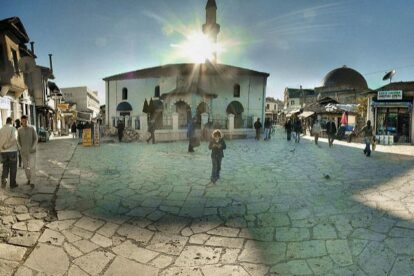
Skopje Old Town – by Panoramas
Maybe, that’s one of the reasons that lead the new government to launch an ambitious, as well as highly criticised, project of urban renewal. With the aim of giving the city the majestic look every capital deserves, ‘Skopje 2014’ allowed for a dramatic makeover of most administrative and cultural buildings, squares and bridges of the Macedonian capital, along with the construction of new ones.
Surely, another reason is that Skopje, following the 1963 devastating earthquake, which caused the loss of most of the city’s distinctive Ottoman and Neoclassical architecture, was rebuilt in a modernist/brutalist architecture (few might now that renowned architect Kenzo Tange lead its reconstruction). Back then, this daring and state-of-the-art choice made Skopje’s cityscape ultra modern, yet grey and dreary. ‘Skopje’s 2014”s Ottoman and Greek-revival style developments, pompous marble monuments and overdecorated public spaces – which are also, no more no less, the aesthetic manifesto of a revamped national identity and pride – earned Skopje the reputation of ‘Europe’s new capital of kitsch’.
Yes, compared to other European centers Skopje indeed lacks some relevance, notoriety and flair. Still, its architectural patchwork of ancient minarets, concrete tower blocks and ‘antiquated’ buildings exercise fascination. Its multiethnic soul – for our Spotter Tatiana, Skopje ‘feels like a small Istanbul, where Orientalism meets the Occident’- emerges when sipping tea in one of its kafanas (local bistro), in the alleys of the Old Bazaar and in the colourful melting pot of its inhabitants. Its fresh appearance in the European scene has made it a vibrant place where there’s a lot to be done, a city projected towards the future, and that still holds a very distinctive and authentic identity.
Yes, Skopje still has to be understood. And, above all, discovered.
That’s why you should spend two days (as a local, of course) in Skopje.
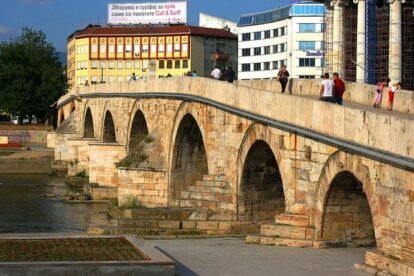
Skopje Stone Bridge – by Antti T. Nissinen
Day 1: 09:00 – 13:00
Breakfast at mix-crowded Broz Kafe is even more enjoyable when the sun shines over Skopje and the temperatures are warm. Its terrace is one of its strong points. And its coffees, definitely its coffees. According to Spotter Bojana, Broz has one of the finest choices of coffee in the whole city, and every day they proposes a more unusual ‘coffee of the day’. Otherwise, in case you’re too impatient to get acquainted with the city, Intenso Caffe 7gr offers over 20 different types of espresso on its menu, coming from a wide range of countries. Drink it like Italians do (very quickly) and start off your first day in Skopje.
Day 1: 13:00 – 19:00
Despite having lost part of its historical heritage, Skopje still conserves traces of its Ottoman past. The Old Bazaar of the city is a picturesque maze of streets and passages with tiny cute shops, bars and restaurants that serve typical Macedonian and Turkish dishes.
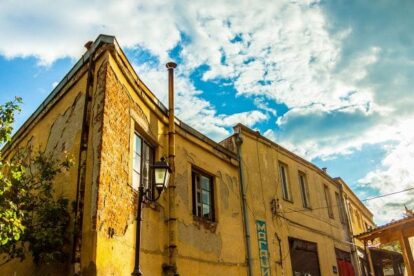
Old Bazaar – by Vladimir Ristevski
Among them, our Spotter Vladimir suggests Galerija 7 for its wonderful Turkish food and tea. Also in the area, visit the Daut Pasha Hammam: once a bath house, as the name suggests, some of its asymmetrical domed rooms host the National Art Gallery, while others are used for other cultural and artistic events. And before evening comes, don’t forget to have a drink on the Hotel Arka terrace, open 24/7. Right in the heart of the Old Bazaar, you will enjoy a stunning view of the city and its surroundings.
Day 1: 19:00 – 23:00
The Macedonian traditional cuisine is rich and many of its dishes are meat-based. Spotter Boban suggests Guesthouse Dukat as the right place to have a tasty bowl of stew. Decorated as an old country house, this restaurant also has a nice selection of wines. And if you have not had enough of the local spirits, head to Concept 37, a gathering place which is a bar and a popular cultural venue that hosts exhibitions, gigs and talks. It also haS a small part dedicated to design products that you can buy.
Day 1: 23:00 – …
Locals like to party hard in Skopje. The city offers a wide choice of parties for everyone’s taste. Depending on the night, Sektor 909 offers a different selection of music and is thought to be one of the best clubs in town. Alternatively, go to Nola Bar: a cozy bar during the day, it becomes one of the city’S hot spots during the night. Its Saturday night parties are considered the best ones in town, and IN the warm season its beautiful garden is the among the coolest dance floors you can find in Skopje.
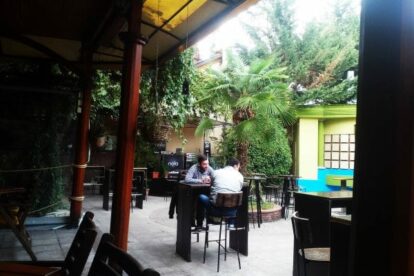
Nola – by Tatiana Moriari
Day 2: 9:00 – 13:00
Nothing better than a healthy breakfast to start your second day in Skopje – especially if you had a late night the day before. Vega is a bar/shop where you can find a wide range of tasty smoothies, vegan dishes and homemade dark chocolate at cheap prices. Everything is fresh and high-quality, and a good vitamin boost will help you gather some strength for your next adventure, which could take place just right outside of the city. Despite being fairly small, Skopje can be overwhelming and hectic. So why not escape to nature, take a cable car and go all the way up to the Vodno Mountain? Just 20 minutes south of the city centre, Vodno offers a breathtaking view of the city. The sportiest ones can hike or bike to its top. From there, you can either go back to Skopje or hike all the way to Matka Canyon. Whether you decide to visit the numerous monasteries and churches of the area, go rock climbing, canoeing or explore its hidden caves, Matka Canyon will remain stuck in your memory for its uncontaminated beauty.
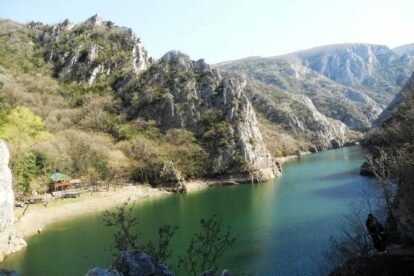
Matka Canyon – by Tatiana Morari
Day 2: 13:00 – 19:00
If you have decided to make your way back to the city, take the chance to walk around Debar Maalo, a cool and characteristic neighbourhood right outside Skopje’s city centre. Quiet and busy at the same time, Debar Maalo is home to many kafanas, restaurants and bars (such as the hidden Kultura and the chilled Cresha Bar). Just around the corner, stop over at Preplet. A shop and creative atelier, Preplet offers a handcrafted and constantly updated selection of design items created by Viktorija and Magdalena, the two girls who run it. From boxes and cups to bag and pillows, you can be sure you won’t leave empty handed.
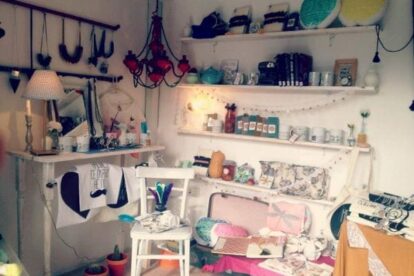
Preplet – by Viktorija Lagovska
Day 2: 19:00 – 23:00
After having hiked (or shopped) the whole day, you deserve to treat yourself with a big, fat meal. At the edge of Debar Maalo, DM doesn’t stand out for its design, but for the massive portions of grilled meat that are served to its customers. Anything you order will fill your stomach and fulfill your palate (DM is one of the best barbecue places in Skopje). And if you can still walk after so much food, slowly walk towards Speakeasy or to AKSC. The first, that gets its name from the retro allure that characterised the establishments selling illegal alcohol during the Prohibition era, offers cocktails that mix authentic Macedonian tastes with already well known ones. The second, an autonomous cultural zone set up by young activists and artists, is the place to go to attend exhibitions, readings and cultural events.
Day 2: 23:00 – …
End your second and last day in Skopje with a blast. If you’re seeking an alternative vibe, Ku La is the place to go to. Similar to AKSC for its multipurpose vocation, Ku La is a popular and alternative indoor and outdoor creative space with a bar that hosts a number of events, among them film screenings and live performances.
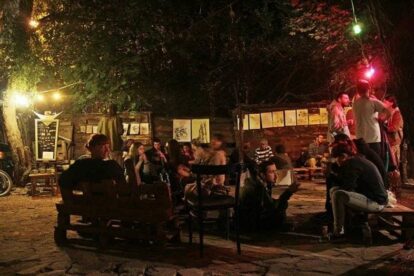
Ku La – by Ku La
Instead, if you want to dance till your feet are sore or see a local band performing, enter Jukebox. This crowded and small venue is popular among Skopje’s artsy crowd and always has a good lineup.
More? Check our Skopje blog or app!

![10 Unique Flea Markets in Europe [2024 Update!]](https://www.spottedbylocals.com/wp-content/uploads/midnightbazar-munich-by-ayla-amschlinger.jpg)
